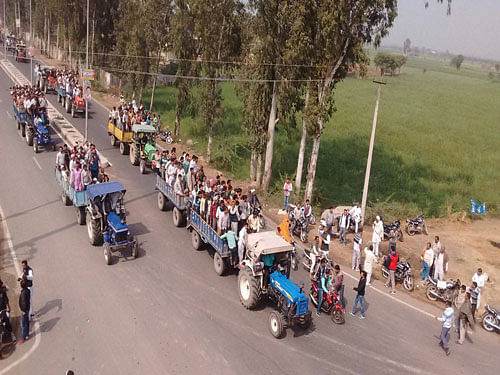An ugly caste divide, a largely agriculture caste believing that it is losing out to other reserved castes in government jobs and seats in educational institutions and competitive political brinkmanship are seen at the root of circumstances that had Haryana on the boil.
Jats, who are an agricultural caste group in Haryana (and in Uttar Pradesh and Rajasthan), are demanding reservation in government jobs and educational institutions under the OBC category. Jats comprise 27 per cent of the electorate in Haryana. At least, they dominate a third of the 90 Assembly constituencies in the state.
The trouble goes back to 1991 when the Gurnam Singh Commission report included Jats in the backward classes category along with seven other groups. But the Bhajan Lal government withdrew the notification for implementing the panel’s recommendation. Subsequently, two more backward classes commissions set up in the state did not include the Jats.
In April 2011, Congress chief minister Bhupinder Singh Hooda, who was in power between 2004 and 2014, set up the K C Gupta Commission which recommended the inclusion of Jats and four other castes–Jat Sikhs, Ror, Tyagi and Bishnoi– in the category Special Backward Classes (SBC).
The Hooda government accepted the report and 10 per cent quota was granted to the Jats. In 2014, just before the Lok Sabha polls, the UPA government had included Jats in the Centre’s OBC list after overruling objections from the National Commission for Backward Classes. But on March 17, 2015, the Supreme Court quashed the UPA government’s decision to extend the OBC quota in central government jobs to the Jats, refusing to accept that the Jats were a backward community. The court said the National Commission for Backward Classes – set up in 1993 after SC verdict in Indira Sawhney (Mandal case) – had rejected the idea after examining the issue.
Consequently, the reservation introduced for the Jats in Haryana and eight other states — Gujarat, Madhya Pradesh, Bihar Himachal Pradesh, Delhi, Bharatpur and Dholpur districts of Rajasthan, Uttar Pradesh and Uttarakhand — was set aside. In April 2015, a review petition filed by the NDA government was also dismissed.
This upset the Jats who have been assertive about their right to dominate the political landscape.
They were livid that, of the 80 castes, only their caste and 15 smaller group do not find mention in the lists of Scheduled Castes and Backward Classes notified by the Haryana government.
Enjoying clout under several Jat chief ministers, they were upset that the BJP government led by Manohar Lal Khattar, a Punjabi, took charge in 2014. Khattar sought to restore the balance in favour of non Jats, who supported the BJP to come to power for the first time on its own strength in the state. That added gunpowder to the boiling pot.
Unlike last non Jat chief minister Bhajan Lal who understood the Jat politics and also ensured the non Jats did well, Khattar was a novice in this regard. The Jats’ alienation was unstoppable.

